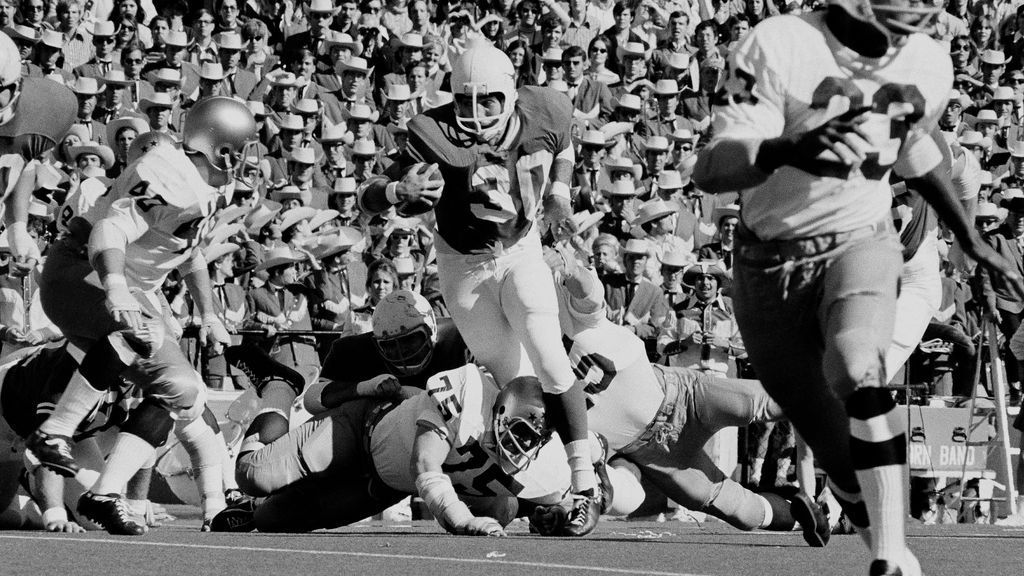Steve Worster, a two-time All-American at Texas and the bruising fullback who was the inspiration for the creation of the wishbone offense that came to dominate college football in the 1970s and ’80s, died on Saturday at 73.
Texas announced Worster’s death in a release on Sunday.
Worster, who was nicknamed “Big Woo” or “Woo Woo” by Longhorns fans, signed with Texas in 1967 as a 6-foot, 210-pound high school star who ran for more than 5,000 career yards at Bridge City High School in Southeast Texas, part of a heralded recruiting class that was known as the “Worster Crowd.” The group would lead Texas to 30 consecutive wins and national championships in 1969 and 1970 behind a new offense tailored to take advantage of Worster’s strength in front of a fleet-footed backfield tandem of Ted Koy and Chris Gilbert.
The wishbone, as it was coined by Houston sportswriter Mickey Herskowitz, would become the game-changing offense of its day, leading Texas to those titles and later followed by the ascension of Barry Switzer’s Oklahoma Sooners and Bear Bryant’s rebound at Alabama.
The wishbone was introduced by Longhorns coach Darrell Royal’s offensive coordinator, Emory Bellard, who had the enviable task of juggling too much talent in the backfield, including Worster, who had rushed for 28 consecutive 100-yard games in high school, still the fourth-longest string in state history.
In the formation, there were three running backs with Worster, the fullback, lined up directly behind the quarterback. Two running backs were positioned farther back, on either side of the fullback, in a Y, or wishbone shape. Royal acknowledged Worster’s abilities when Duffy Daugherty, the Michigan State coach, called to ask for pointers on the new scheme.
“You don’t want my offense,” Royal said in a 1969 Sports Illustrated article. “You want my fullback, and he’s got two more years with me… He’s the kind of kid who just goes out and causes wrecks, straightens his headgear and walks back to the huddle quietly.”
Since freshmen were ineligible at the time, Worster didn’t start until 1968, when the Longhorns finished No. 3 in the country. They then went on a historic run over the next two seasons as Worster became a national star, including making the cover of Sports Illustrated with the caption, “Woo Woo Worster on a rampage.”
The Longhorns went 30-2-1 and won Southwest Conference titles in every season Worster started and he finished with 2,353 yards and 36 touchdowns in his career, finishing as the Longhorns’ second-leading rusher in history at the time. He finished fourth in the 1970 Heisman voting behind Stanford’s Jim Plunkett, Notre Dame’s Joe Theismann and Archie Manning of Ole Miss.
Worster is a member of the Texas Longhorn Hall of Fame, the Texas High School Hall of Fame and the Cotton Bowl Hall of Fame on the strength of his 1970 performance against Notre Dame when he ran for 155 yards on 20 carries in a 21-17 Texas win that clinched a national title.
Worster was already a legendary high school star before arriving at Texas, running for 2,210 yards in his senior year, including 249 yards and three touchdowns in a 30-7 win against a McKinney team that had 10 shutouts in 13 games and had allowed just 16 points all season. After Worster became a college star, Bridge City residents were so proud that they finally voted to incorporate the city after twice failing before, according to the former mayor, Kirk Roccaforte. Worster literally put his hometown on the map.
“There’s never been a more celebrated high school athlete that produced to the level of his high school hype,” said teammate and fellow member of the Texas Athletics Hall of Honor Bill Zapalac, who was also in the 1967 class of signees.
After Texas, Worster lost interest in football despite being drafted in the fourth round by the Los Angeles Rams. He played one season in Canada, before returning home, because he said he had been raised “Southeast Texas solid” and was just interested in making a decent living and raising a family.
“Football had provided me everything that I wanted it to provide me and everything that had been promised to me,” he told the Beaumont Enterprise in 2010 when he was honored in Bridge City.
Worster is survived by a daughter, Erin, and a son Scott.
